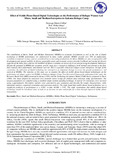Effect of Mobile Phone-Based Digital Technologies on the Performance of Refugee Women-Led Micro, Small and Medium Enterprises in Kakuma Refugee Camp

View/
Date
2023-11-04Author
Onyango, Otieno Collins
Otuya, Willis
Nanyama, Rosemary
Metadata
Show full item recordAbstract
The contribution of Micro, Small, and Medium Enterprises (MSMEs) to economic development as well as the role of digital technology in MSME performance are underscored in many studies globally. MSMEs provide over 70% of employment, contribute to national revenue, and are considered key to increasing productivity. In Africa, MSMEs are also recognized for skill development and upward mobility in diverse geographic areas and economic sectors, provide livelihood and income for diverse segments of the labor force, and are the backbone of Africa’s economy as well as key to its most pressing development challenges. Despite the potential of MSMEs for economic growth, many face a myriad of challenges, both internal and external to the firm, that constrain their performance and ultimate survival. This is especially critical for refugee-owned enterprises. In light of the constraints, the utilization of digital technology has emerged as an important strategy to secure the growth, performance, and survival of MSMEs. The objective of this study was to examine the effect of mobile phone-based digital technologies on the performance of refugee women-led MSMEs in Kakuma Refugee Camp. Two theoretical frameworks underpinned this study: the Resource-Based View (RBV) proposed by Barney (1991) and the Technology Acceptance Model (TAM) theory proposed by Davis (1986). The study adopted an analytical cross-sectional survey design for primary data collection using questionnaires. The targeted population was sampled using a stratified simple random sampling technique. A total of 111 enterprises were surveyed using a questionnaire. Descriptive statistics were generated to give summaries and describe the sample characteristics, while inferential statistics comprised correlation and regression analysis. The study found that mobile phone-based technology was a significant predictor of performance (r = 0.501, p-value =0.000 < 0.05). The study recommends that mobile phone-based technology should be prioritized since it leads to an increase in sales and profits for a firm through improved mobile phone transactions.
URI
https://doi.org/10.51867/ajernet.4.2.77https://ajernet.net/ojs/index.php/ajernet/article/view/184
http://ir-library.mmust.ac.ke:8080/xmlui/handle/123456789/2442
Collections
- Gold Collection [1026]
